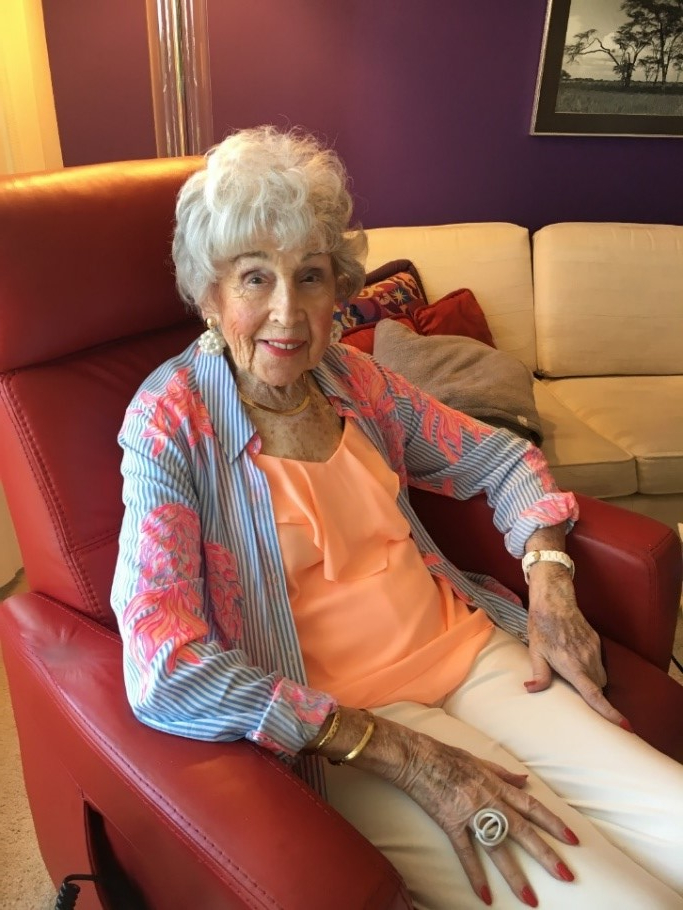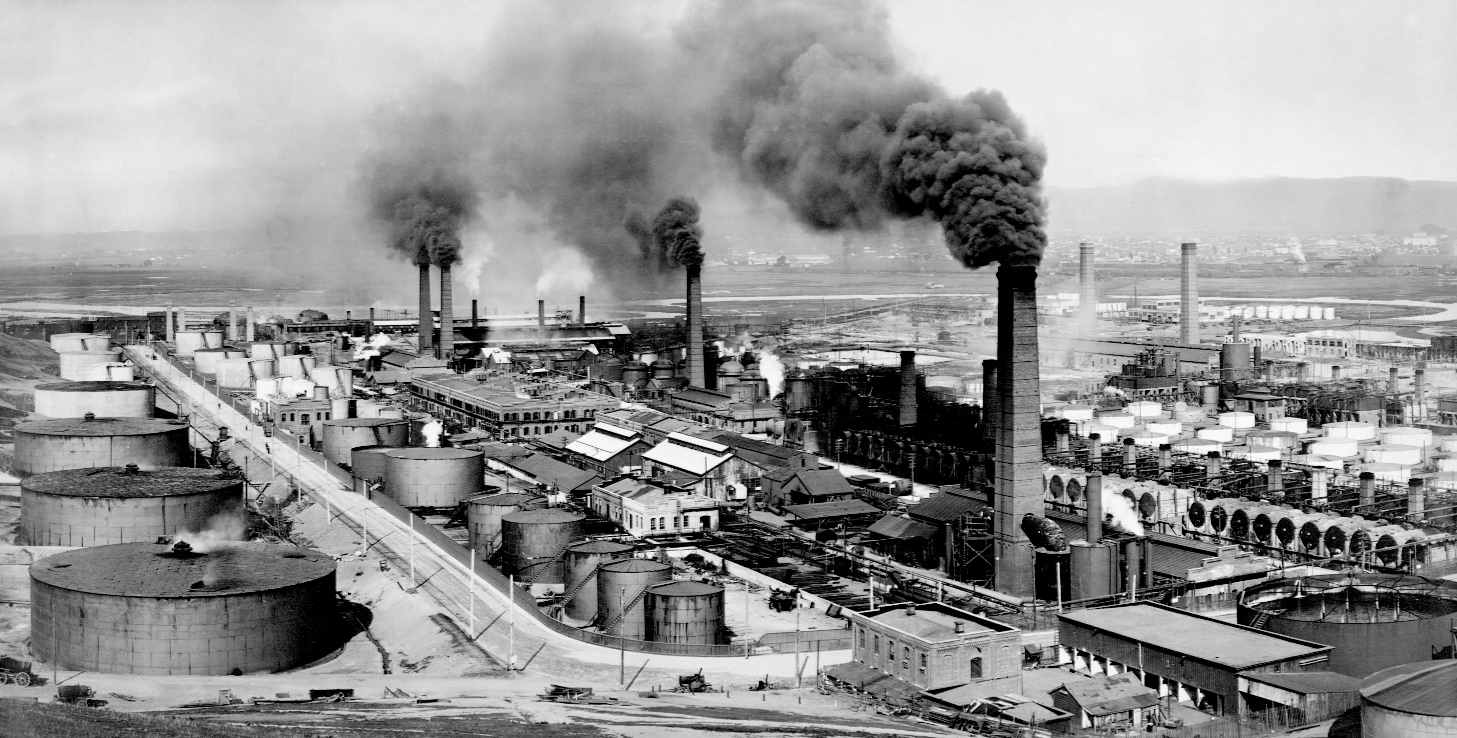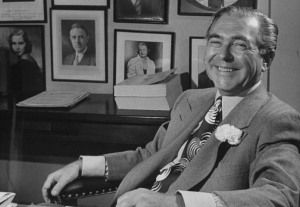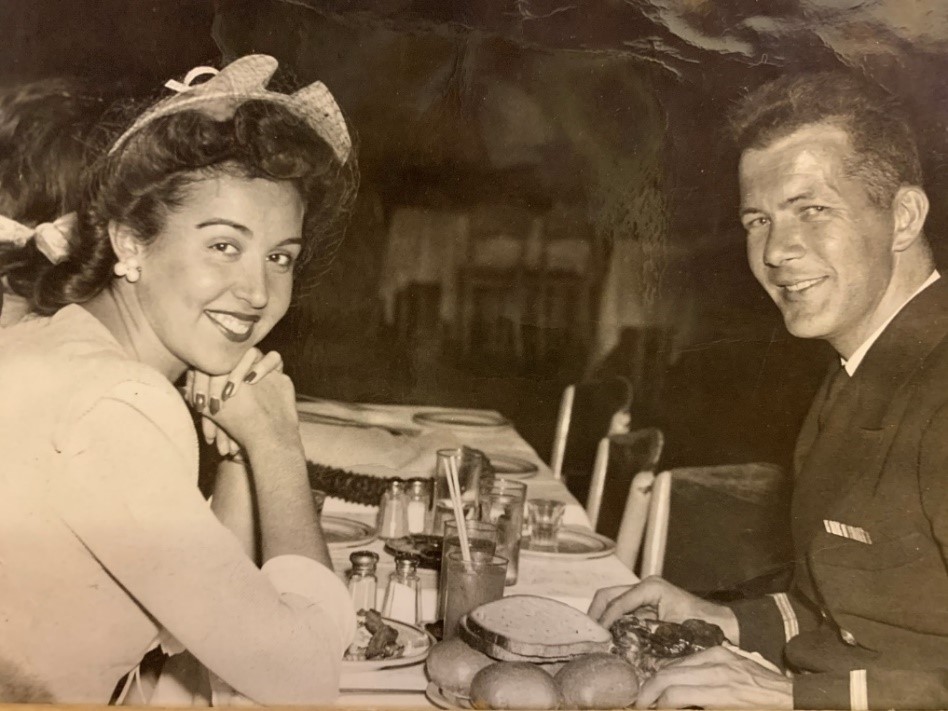
Interview with Mrs. Toni Breihan:
A Favorite Secretary of Steve Hannagan
From New York model and secretary, to WWII war bride, to 1950’s St. Louis homemaker, to supportive parent and volunteer, to a professional St. Louis tour guide and trainer, to St. Louis Cathedral docent, to world traveler and lifelong learner, to senior living dining-out organizer—Mrs. Toni Breihan has led a remarkable life over the past 100 years.
Miss Toni Corcoran began her life a century ago on July 2, 1920, in New York City. Always precocious and in search of adventure, she graduated early from high school, attended business school in Manhattan, and began an exciting career as a secretary/personal assistant. Among her employers was the press agent legend Steve Hannagan, who developed some of the first big publicity campaigns for the Indy 500, Miami Beach, Sun Valley, and Las Vegas. She had a valuable asset that Hannagan liked—her Irish name and heritage. He hired children of the Irish whenever he could, finding them loyal and hardworking. Hiring the Irish made Hannagan feel good about his own Irish background.
When Toni worked at Steve Hannagan & Associates in New York City, she worked directly with his Executive Assistant Margaret Ray, who was Hannagan’s chief assistant from the early 1920s at the Indianapolis 500 to his passing in 1953.
While working for Steve Hannagan, Toni found his top assistants, Larry Smits and Joe Copps, provided levity to the intense work day that could last twenty-four hours in the midst of a big campaign. Although the work was intense with long hours, as a young woman, it was also a fun and often exciting time working for Hannagan and Associates.
Steve hired former college athletes for their star power in various press and promotional campaigns. The “Hannagan Athletes” did not take their heroic image seriously, but they were great fun. They seemed to always be up to something, slipping away every afternoon to the first-floor coffee shop to spend time with the John Powers, high-powered fashion models who were in the same building on Park Avenue. Hannagan often had to stomp down to the coffee shop where he bellowed for his lost employees to return to work.
One of Toni’s favorite employees at Hannagan & Associates was Paul Snell, who operated out of Hollywood. He brought stars along with him when he came to New York. Another favorite was Kathy Harriman, Averill Harriman’s daughter. Mr. Harriman was President of the Union Pacific, head of a major investment firm, advisor to President Roosevelt, Coordinator of Lend-Lease in London, and Ambassador to Russia. Steve Hannagan promoted Harriman’s Sun Valley project. Harriman hired Steve to turn an unknown ski resort in Idaho into an international destination and a recreation site for Hollywood stars and Eastern elite. During World War II, Harriman wanted his daughter to accompany him to London on a business trip, but England did not permit visitors. So, Steve hired Kathy Harriman as an Associate in London where she became good friends with Randolph Churchill’s (Winston Churchill’s wayward son) wife Pamela. Years later, Pamela, after divorcing Randolph Churchill, married Avril Harriman, becoming Kathy Harriman’s step-mother.
Anyone who knew Hannagan in this period knew that he was an exercise and health pill fanatic. Regularly, he would call Toni into his office to join him in his calisthenics routine. For Toni, this meant changing from her work attire into exercise apparel and then back. In speaking with Toni, she noted that she enjoyed the break but would have liked showering before returning to work!
While working at Hannagan & Associates, Toni produced most of Steve’s letters. He always ended each letter with the happy phrase – ‘Cheerfully yours, Steve’. Many of his letters are floating around in corporate and research library archives; but sadly, Steve’s files were lost to an overly- zealous janitor. When Hannagan & Associates set his files out to be stored, a janitor sent them instead to the incinerator. Many famous letters were lost to history.
Toni remembered working with Steve Hannagan as one of the great moments in her life.
After leaving Hannagan & Associates. Toni worked as a hat model for a New York designer and was known as “Miss C” because they thought she had a bit of “attitude.” Toni also volunteered as an Officers’ Club hostess during World War II, where a deeply-tanned, blond Navy lieutenant in his dress whites, just back from fighting in the South Pacific, swept her off her feet. She and Erv Breihan ended up tying the knot in 1945 and eventually settled in the officer’s home town of St. Louis.
Toni Corcoran Breihan & George Gunderson, a WW II soldier from Holland
St. Louis in the late 1940s was quite a shock for this lively New Yorker who was accustomed to the orchestra striking up her favorite tune when she entered a night club like the Copacabana. But she quickly assimilated, learning to love the city where she would live the rest of her life. In fact, she became one of its biggest cheerleaders.
Toni and Erv raised three children, first in Affton and then in unincorporated South St. Louis County, where they built their home Star Hill in 1959 on ten acres of land—an idyllic place to live. Toni also trained and showed her Shetland Sheepdog named Laddie in Obedience trials— teaching him to retrieve dumbbells, to jump over hurdles, and to find her scent on one article hidden among many. She and Laddie were very successful, winning many trophies; they even demonstrated their skills on The Charlotte Peters television show broadcast on KSD-TV (now KSDK).
Erv was a noted expert on airport and highway construction and also served as President of the Missouri Society of Professional Engineers. Toni was active in the corresponding organizations for engineers’ wives, planning the ladies’ programs for numerous conventions. Toni and Erv were charter members of the St. Louis Ambassadors, organized in the 1960’s under Mayor Alfonso J. Cervantes to promote the revitalization of St. Louis. Toni and Erv also invested in the Goldenrod Showboat on the St. Louis riverfront, helping to renovate it, including spending a weekend washing the pieces of crystal from its chandeliers.
Toni retired from many of her community engagements in the 1990’s, but she became a docent at the Cathedral Basilica of St. Louis and gave tours of the Basilica. She always cherished the Cathedral, partly because her next-door neighbor and dear friend, Arno Heuduck, and his father had created most of the famed mosaics there.
When Erv passed away in 2002, Toni entered another stage of life. Never one to sit still for long, she soon began organizing Dining Out with Toni—where she would research St. Louis restaurants and set up a monthly dinner out with her building residents.

Toni Corcoran Breihan at home in St. Louis
Toni met another man who became significant in her life—Bill Malcolm. Bill was a widower who loved to sing Frank Sinatra-style songs and entertained in various locales. Toni even picked up modeling again—frequently working for a local “real people” modeling agency in print and television ads. Bill passed away in 2016, and Toni has continued to enjoy her many friendships. Walking is not quite as easy as it was a year ago, but Toni is still a lively conversationalist, voracious reader, fashion lover, and Jeopardy fan.
Toni Breihan has made her 100 years on earth count!
Did Steve Hannagan Help Standard Oil Oppose Mexico’s Expropriation of Foreign Oil Companies?
The Blog author has received a question: “Could we confirm if Steve Hannagan was in charge of a campaign on behalf of the Standard Oil Corporation in 1938 following the expropriation of their assets in Mexico?” After researching this question, I cannot conclusively answer it; however, there is some history in Wikipedia that may be helpful.[1]
The expropriation of Standard Oil’s assets in Mexico took place following an ongoing dispute between the Petroleum Workers Union of Mexico and all foreign oil companies operating in Mexico at the time. The dispute started on August 16, 1935, when the Petroleum Union presented the companies with a demand for payment of 65 million pesos to compensate them for below-market wages and benefits. The oil companies refused and counter offered with 14 million pesos. The dispute went to the Arbitration Board, which sided with the Union.
After several years with no action by the companies on the ruling of the Arbitration Board, the Union issued a demand to the foreign oil companies on November 3, 1937, to sign the agreement. By May 17,1938, with the issue still unsettled, the Union called for a strike that began on May 28, 1938.
On June 9, 1938, following the advice of the President of Mexico, the Union lifted the strike. He counselled the Union leaders to present their case to the General Arbitration and Conciliation Board. The Board formed a commission of financial experts who investigated the petroleum companies’ finances and concluded that their profits easily permitted them to cover the demands of the workers. The Board ordered the oil companies to pay 26 million pesos for wages and benefits to the workers. However, the oil companies’ management claimed that the amount of the payment would bankrupt them, and they again refused to pay the judgement.
Despite the Arbitration Board’s order to make payment, the companies continued to ignore the Board’s order; and by December 8, 1938, management began hiring new employees to replace Union workers. On December 18, the Arbitration Board made a formal declaration in favor of the Union by means of a “laudo” (binding judgment in arbitration) which demanded that the companies fulfil the requirements of the petitions and pay 26 million pesos in lost salaries. The petroleum companies filed a lawsuit on January 8, 1939, to protect their property from the Arbitration Board’s declaration. The court subsequently rendered their decision on March 1, giving the companies until March 7 to pay the 26 million pesos penalty.
The refusal of the companies to comply with the court rulings led to the President nationalizing the U.S. and Anglo–Dutch oil operating companies on March 18, 1939. On June 7, 1939, President Cárdenas issued a decree creating PEMEX (Petróleos Mexicanos) with exclusive rights over exploration, extraction, refining, and commercialization of oil in Mexico. On June 20, PEMEX started operations and took over the assets of the foreign oil companies.
The oil companies retaliated with a public relations campaign against Mexico, urging people to stop buying Mexican goods and lobbying to embargo U.S. technology to Mexico. Many foreign governments closed their markets to Mexican oil, hoping that PEMEX would drown in its own oil. U.S. oil companies did not get any support from the U.S. government either because of President Franklin D. Roosevelt’s Good Neighbor Policy to recalibrate U.S.-Latin American relations.

Standard Oil Refinery – Mexico[2]
So back to the question of whether Steve Hannagan ran the Standard Oil press campaign opposing the expropriation of their operations by the Mexican government. The question is difficult to answer for two reasons. Firstly, Hannagan’s files were destroyed after his death when they were incinerated by a cleaning crew who misidentified the files as trash. Secondly, the files of Standard Oil on this matter are unavailable.
Endnote
-
The discussion paraphrases an article found in Wikipedia; “Mexican Oil Expropriation”; https://en.wikipedia.org/wiki/Mexican_oil_expropriation. ↑
-
Sanchez, Karina Cerino; Historia de la Industria Petrolera en Mexico; (Retrieved August 18, 2020): https://www.bing.com/images/search?view=detailV2&ccid=F8E8GrWv&id=6006C2B7DE04E81FE01900F992C7B092D22882B8&thid=OIP.F8E8GrWvtAGXI6MPZnPowQHaFo&mediaurl=https%3a%2f%2fi.pinimg.com%2foriginals%2f82%2f9a%2fc3%2f829ac3eea2130c93c91bf02d7980f37f.jpg&exph=954&expw=1255&q=standard+oil+mexico+refineries&simid=608030295307194020&ck=5585B6F40931F959D10F48F7FD560E71&selectedIndex=8&FORM=IRPRST&ajaxhist=0 ↑

